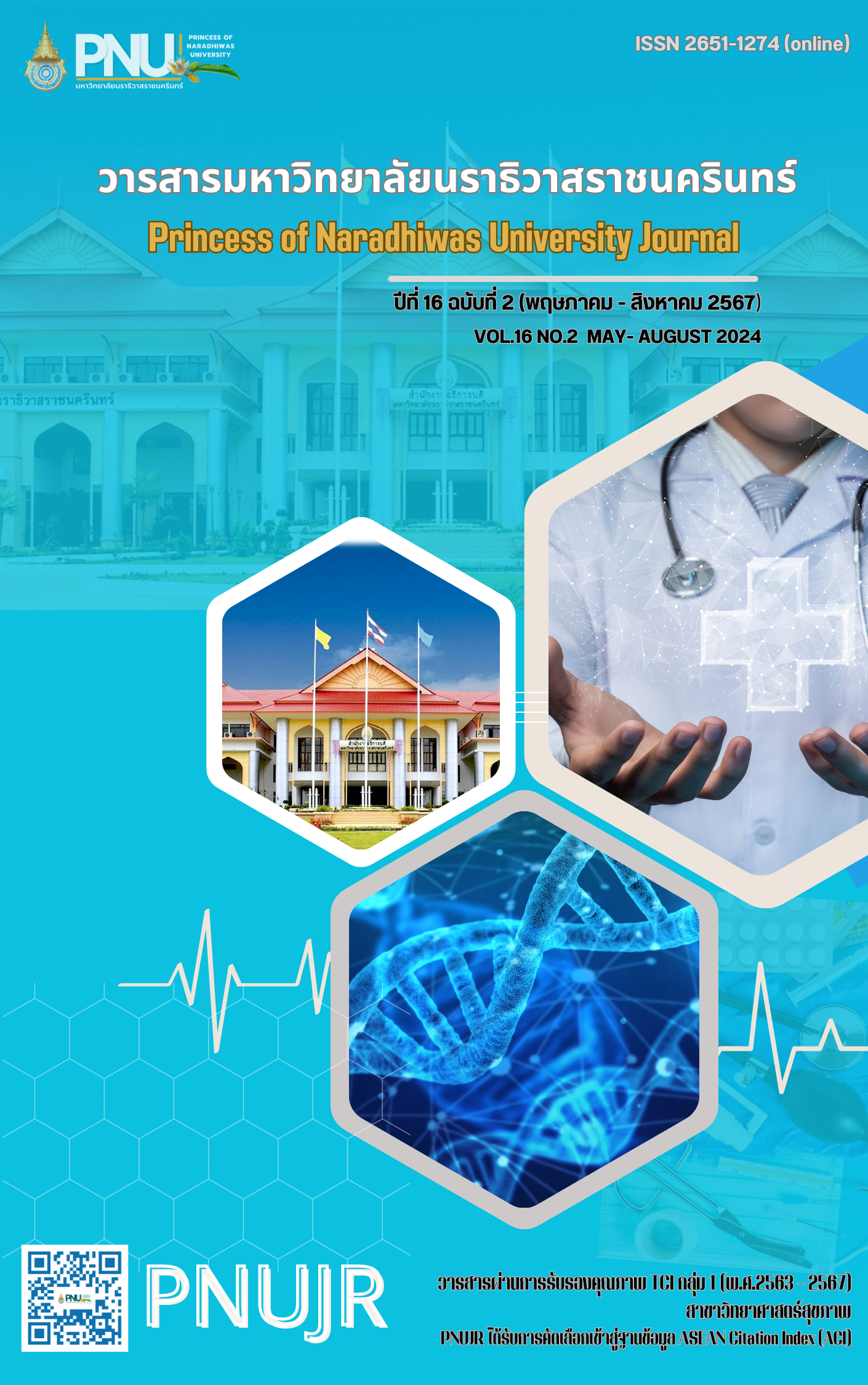การศึกษาความเหนื่อยหน่ายของพยาบาลวิชาชีพที่ปฏิบัติงานในโรงพยาบาล ระดับตติยภูมิแห่งหนึ่งของภาคใต้
ฟาอิส วาเลาะแต
คำสำคัญ:
ความเหนื่อยหน่าย, พยาบาลวิชาชีพ, โรงพยาบาลระดับตติยภูมิแห่งหนึ่งของภาคใต้บทคัดย่อ
การวิจัยเชิงพรรณนานี้ มีวัตถุประสงค์เพื่อ 1) ศึกษาระดับความเหนื่อยหน่ายของพยาบาลวิชาชีพที่ปฏิบัติงานในโรงพยาบาลระดับตติยภูมิแห่งหนึ่งของภาคใต้ และ 2) เพื่อศึกษากลวิธีการลดความเหนื่อยหน่ายของพยาบาลวิชาชีพที่ปฏิบัติงานในโรงพยาบาลระดับตติยภูมิแห่งหนึ่งของภาคใต้ กลุ่มตัวอย่างแบ่งเป็น 2 กลุ่ม ได้แก่ กลุ่มตัวอย่างที่ตอบแบบสอบถาม จำนวน 30 คน และกลุ่มตัวอย่างที่ร่วมสนทนากลุ่มย่อย จำนวน 10 คน โดยคัดเลือกจากกลุ่มตัวอย่างเดียวกัน เครื่องมือวิจัยประกอบด้วย 1) แบบสอบถามวัดระดับความเหนื่อยหน่ายของพยาบาลวิชาชีพ มีค่าความเที่ยงโดยหาค่าสัมประสิทธิ์แอลฟาของครอนบาค ได้เท่ากับ 0.85 และมีค่าดัชนีความตรงเชิงเนื้อหาเท่ากับ 1 และ 2) แบบสัมภาษณ์ข้อคำถามกึ่งโครงสร้างใช้ในการสนทนากลุ่มย่อยของพยาบาลวิชาชีพ มีค่าความเที่ยงโดยหาค่าสัมประสิทธิ์แอลฟาของครอนบาค ได้เท่ากับ 0.97 และมีค่าดัชนีความตรงเชิงเนื้อหาเท่ากับ 1 การวิเคราะห์ข้อมูลโดยใช้สถิติเชิงพรรณนา ได้แก่ ค่าร้อยละ ค่าเฉลี่ย และค่าส่วนเบี่ยงเบนมาตรฐาน และการวิเคราะห์เนื้อหา
ผลการวิจัย พบว่า ความเหนื่อยหน่ายของพยาบาลวิชาชีพที่ปฏิบัติงานในโรงพยาบาลระดับตติยภูมิแห่งหนึ่งของภาคใต้ โดยรวมอยู่ในระดับปานกลาง (M = 2.50, S.D. = 0.65) โดยพิจารณาเป็นรายด้านพบว่า ด้านที่ทำให้เกิดความเหนื่อยหน่ายที่มีค่าคะแนนเฉลี่ยมากที่สุด คือ ด้านงาน ซึ่งอยู่ระดับปานกลาง (M = 3.19, S.D. = 0.94) รองลงมา คือ ด้านองค์กร และด้านบุคคล (ความอ่อนล้าทางร่างกาย) ซึ่งอยู่ในระดับปานกลาง (M = 2.68, S.D. = 0.90, M = 2.66, S.D. = 0.74) ตามลำดับ และด้านที่ทำให้พยาบาลวิชาชีพที่ปฏิบัติงานมีความเหนื่อยหน่ายในระดับน้อย โดยมีค่าคะแนนเฉลี่ยเท่ากัน คือ ด้านบุคคล (ความอ่อนล้าทางอารมณ์ และความอ่อนล้าทางการตระหนักรู้) (M = 1.99, S.D. = 0.69, M = 1.99, S.D. = 0.78) ตามลำดับ และกลวิธีการลดความเหนื่อยหน่ายของพยาบาลวิชาชีพจากการทำงาน ได้แก่ 1) การนอนหลับพักผ่อน 2) การดูแลสุขภาพร่างกาย 3) การรับประทานอาหารที่เหมาะสม 4) การวางแผนการทำงาน 5) การจัดตารางเวลาทำงานให้เหมาะสม 6) การสื่อสารกับเพื่อนร่วมงาน 7) การบริหารจัดการความเครียด และ 8) การส่งเสริมสุขภาพจิต
เอกสารอ้างอิง
Axisa, C., Nash, L., Kelly, P., & Willcock, S. (2019). Burnout and distress in Australian physician trainees: Evaluation of a wellbeing workshop. Australas Psychiatry, 27(3), 255 - 261. http://doi.org/10.1177/1039856219833793
Chamakiotis, P., Panteli, N., & Davison, R.M. (2021). Reimagining e-leadership for reconfigured virtual teams due to Covid-19. International Journal of Information Management, Elsevier, 60(C). http://doi.org/10.1016/j.ijinfomgt.2021.102381
Chen, Y.-C, Guo, Y.- L.L, Chin, W.-S, Cheng, N.-Y, Ho, J.-J, & Shiao, J.S.-C. (2019). Patient–Nurse
Ratio is Related to Nurses’ Intention to Leave Their Job through Mediating Factors of Burnout and Job Dissatisfaction. International Journal Environmental Research and Public Health, 16(23), 4801. http://doi.org/10.3390/ijerph16234801
Jintarat, B., & Sithisarankul, P. (2022). Emotional labor and burnout in nursing profession. Journal of
Preventive Medicine Association of Thailand, 11(2), 435 - 446. https://he01.tci-thaijo.org/ index.php/JPMAT/article/view/248421
Klein, A., Taieb, O., Xavier, S., Baubet, T., & Reyre, A. (2020). The benefits of mindfulness-based interventions on burnout among health professionals: A systematic review. Explore (NY), 16(1), 35 - 43. http://doi.org/10.1016/j.explore.2019.09.002
Krejcie, R.V., & Morgan, D.W. (1970). Determining Sample Size for Research Activities. Educational And Psychological Measurement, 30(3), 607 - 610. https://psycnet.apa.org/ record/1971-03263-001
McCormack, N., & Cotter, C. (2013, October). Managing Burnout in the Workplace: A Guide for Information Professionals. https://www.researchgate.net/publication/282177798_ManagingBurnout_in_the_Workplace_A_ Guide_for_Information_Professionals
Ministry of Labor Safety Act Occupational health and working environment. (2021, August 6). The act clarifies responsibilities and duties of employer and employee as well as those of governments. https://enviliance.com/regions/southeast-asia/th/th-osh
Ministry of Public Health. (2021, December 22). Criteria for risk reimbursement of staff working in surveillance, investigation, prevention, control and treatment of patients infected with Coronavirus 2019. https://hp.anamai.moph.go.th/th/manual-ofofficial/download?id=86033& mid=35018&mkey=m_document&lang=th&did=27817
Nantsupawat, A., Nantsupawat, R., Kunaviktikul, W., Turale, S., & Poghosyan, L. (2016). Nurse Burnout, Nurse-Reported Quality of Care, and Patient Outcomes in Thai Hospitals. Journal of Nursing Scholarship, 48(1), 83 - 90. http://doi.org/10.1111/jnu.12187
No-in, K., Cheevakasemsook, A., & Angsuchoti, S. (2021). The development of a reducing burnout model for professional nursesin a community hospital A reducing burnout model for professional nurses in a community hospital. Journal of Mental Health of Thailand, 29(1), 69 – 79. http://he01-tci-thaijo.org/index.php/jmht/ article/view/242178/168170
Omotade, S.J., Okafor, N., Omolayo, F., & Tajat, M.O. (2021). Prevalence of burnout syndrome among clinical nurses working at state hospital, Ijaye, Abekotuka, Ogun state, Nigeria. African Journal of Health Nursing and Midwifery, 4(5), 85 – 101. https://doi.org/ 10.52589/AJHNM-JXC09CBZ
Rezaei, S., Matin, B.K., Hajizadeh, M., Soroush, A., & Nouri, B. (2018). Prevalence of burnout among nurses in Iran: a systematic review and meta-analysis. International Nursing Review, 65(3), 361 - 369. http://doi.org/10.1111/inr.12426
Ramírez-Elvira, S., Romero-Béjar, J.L., Suleiman-Martos, N., Gómez-Urquiza, J.L., Carolina, M., Guillermo, L.F., & Albendín-García, L. (2021). Prevalence, Risk Factors and Burnout Levels in Intensive Care Unit Nurses: A Systematic Review and Meta-Analysis. International Journal of Environmental Research and Public Health, 18(21), 11432. https://doi.org/10.3390/ijerph182111432
Shirom, A., & Melamed, S. (2006). A comparison of the construct validity of two burnout measures in two groups of professionals. International Journal of Stress Management, 13(2), 176 - 200. https://doi.org/10.1037/1072-5245.13.2.176.
Thamrongvisava, S., Pitanupong, J., & Srisintorn, W. (2019). Burnout andassociated factors among nurses at Songklanagarind Hospital. Royal Thai Army Medical Journal, 72(3),177-185. https://he02.tci-thaijo.org/index.php/rtamedj/article/view/218984
Tianjaruwattana, W., & Nawsuwan, K. (2021). Development of the public health workforce of the office of the permanent secretary, Ministry of Public Health to support health region. Journal of Health Science, 30(3), 531 - 546. https://thaidj.org/index.php/JHS/ article/view/10223
Wisetborisut, A., Angkurawaranon, C., Jiraporncharoen, W., Uaphanthasath, R., & Wiwatanadate, P. (2014). Shift work and burnout among health care workers. Occupational Medicine, 64(4), 279 - 286. https://doi.org/10.1093/occmed/kqu009
Yuan, Z., Yu, D., Zhao, H., Wang, Y., Jiang, W., Chen, D., Liu, X., & Li, X. (2021). Burnout of healthcare workers based on the effort-reward imbalance model: A cross-sectional study in China. International Journal of Public Health, 25, 66, 599831. https://doi.org/10.3389/ijph. 2021.599831.
ดาวน์โหลด
เผยแพร่แล้ว
รูปแบบการอ้างอิง
ฉบับ
ประเภทบทความ
สัญญาอนุญาต
ลิขสิทธิ์ (c) 2024 วารสารมหาวิทยาลัยนราธิวาสราชนครินทร์

อนุญาตภายใต้เงื่อนไข Creative Commons Attribution-NonCommercial-NoDerivatives 4.0 International License.




